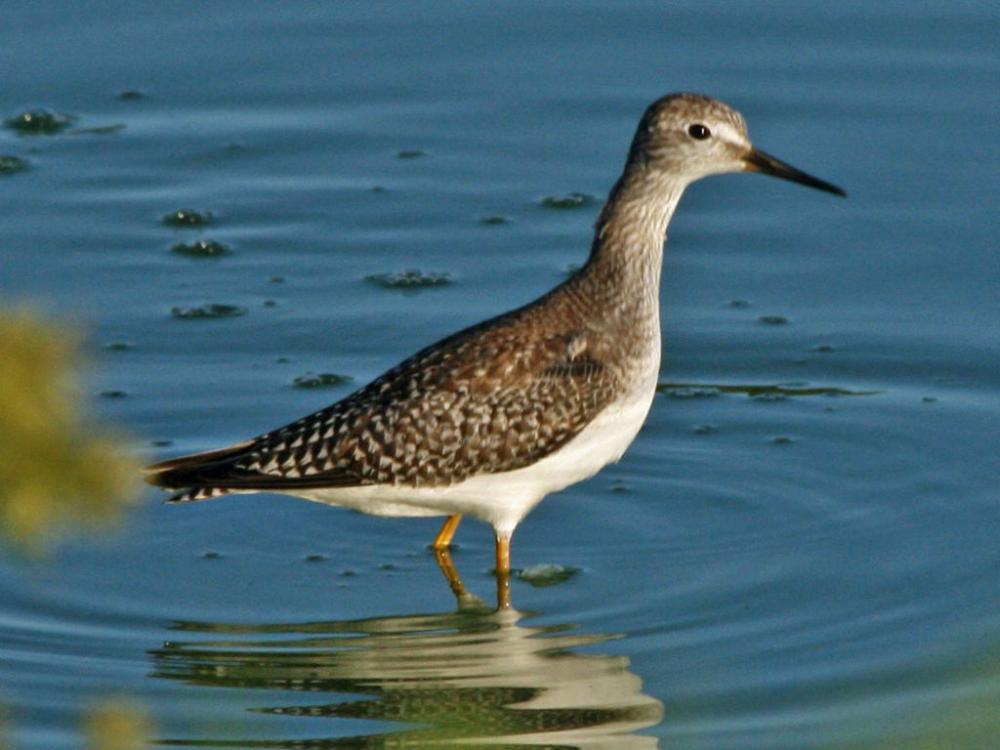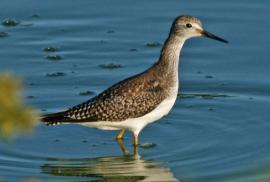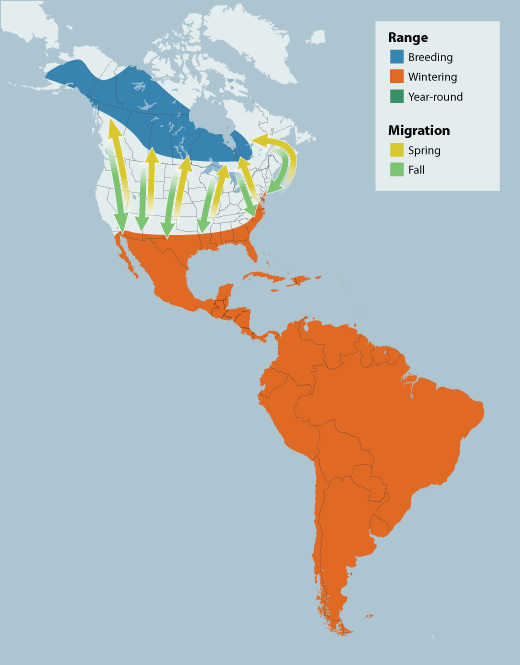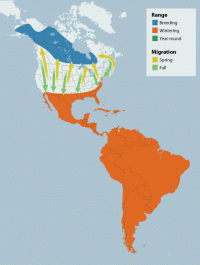Guide to Boreal Birds
This is an in-depth boreal species profile.
What is this?
This species is one of more than 30 birds selected for in-depth profiles. Find out why and see all selected boreal birds »
Overview
It is a standing joke among novice birders that the Greater and Lesser Yellowlegs are really the same species because their appearance is so similar to the untrained eye. Ecologically, however, they are quite different, and recent evidence suggests they may not even be closely related. The Lesser Yellowlegs is the less familiar of the two to North Americans because it winters farther south, with less of its winter range within the U.S. Both are almost entirely boreal in their breeding distributions, though they prefer somewhat different nest sites. North America's boreal forest accounts for virtually all of the species' breeding population.
The Lesser Yellowlegs is tamer than its larger relative and often allows close approach. Both species of yellowlegs bob their heads up and down when watching an intruder. It was formerly a favorite game bird--not because shooting it was good sport but because the birds were good eating--but is now fully protected.
Description
10 1/2" (27 cm). A slender, gray-streaked wader with conspicuous white rump and long yellow legs. A smaller, more slender edition of the Greater Yellowlegs, with a proportionately shorter, straighter, more slender bill. Looks longer-legged than Greater Yellowlegs.
Voice
A flat tu-tu, less musical than call of Greater Yellowlegs.
Nesting
4 buff eggs, blotched with brown, in a slight depression on the open ground near water.
Habitat
The Lesser Yellowlegs typically nests in open boreal forest and forest/tundra ecotone with scattered shallow wetlands. Typical habitat components in breeding territories include trees or shrubs, logs, grassy meadows, and marshy pools with well-vegetated margins. Its nest sites are generally drier and more densely vegetated than those of the Greater Yellowlegs. The rest of the year it utilizes a wide variety of wetland habitats ranging from tidal marshes to alpine lakes and including freshwater marshes, mud and salt flats, swamps, sewage lagoons, sloughs, wet meadows, puddles, flooded agricultural fields, and reservoirs. Habitat use in winter is often strongly tied to rainfall patterns as changing water levels cover or expose foraging habitat. For example, use of rivers and tidal areas is highest in the dry season; in the wet season, birds shift to flooded fields and coastal lagoons.
Range/Migration
As is typical of shorebirds, the Lesser Yellowlegs migrates both north and, especially, south earlier than songbirds, in large part because their young require less parental care. Departure from the breeding grounds is in June for failed breeders, mid-July for successful breeders (females depart ahead of males), and late July to early August (occasionally September) for juveniles. Migration is usually in small groups mixed with other shorebirds; flock size increases during bad weather. Most Eastern breeders fly southeast to the Maritimes and New England, then make short flights south along the Atlantic coast to the southern states. Most Western breeders follow a mid-continental route west of the Mississippi to the Gulf States. Relatively few follow the Pacific coast. Many birds from all populations continue to the Caribbean or cross the Gulf of Mexico to winter in Latin America as far south as Tierra del Fuego; the highest winter concentrations are on the north coast of South America, particularly Suriname. Northward movement begins in February; the first birds reach the breeding grounds by late April and the rest arrive over the next month.
Breeding
The breeding grounds of the Lesser Yellowlegs extend from western Alaska to southern Hudson Bay and south to central Alberta and Saskatchewan. Virtuallyall of the breeding range of Lesser Yellow legs are within the boreal bird conservation regions (BCR) in North America . More than 80% of the species breeds in Canada's boreal region. This species is seasonally monogamous; pairs form shortly after arrival on the breeding grounds. Males, often in pairs or small groups, perform an undulating flight display to attract females both to the area and to themselves. Once they are mated, they guard their mates through the laying period, chasing off potential interlopers. Like most shorebirds, the Lesser Yellowlegs nests on the ground, typically close to water in sheltered sites such as under short shrubs and trees and next to logs and sticks. Both parents incubate the 3-4 eggs for 22-23 days, then lead the precocial young to foraging sites. The young feed themselves from the start but continue to be brooded by the parents at night and during foul weather. The female typically stays with the young less than half as long as the male, sometimes only a few days. There is only one brood per season.
Diet/Feeding Behavior
Most information on the Lesser Yellowlegs' diet comes from fall migrants. Like other shorebirds, it is almost entirely carnivorous, though it occasionally eats seeds. Its primary prey is flies and beetles, especially those procured in aquatic habitats. Other foods include snails, naiads, worms, spiders, and a few fish and fish scales. It usually appears to select prey on the basis of availability, though some studies have found it to select certain prey disproportionately, even in the presence of prey often consumed at other locations. Its feeding behavior is typical of the genus; it usually walks rapidly and erratically through shallow water, picking up food it encounters. It also sometimes employs other methods including probing, snatching flying insects, plucking insects off vegetation, sidesweeping through water or liquid mud with the bill, and catching arthropods on land. It has been observed following other shorebirds and ducks and eating prey revealed by those species. It forages both day and night, using visual methods in daylight and tactile methods in darkness.
References
Bart, J., B. Andres, S. Brown, G. Donaldson, B. Harrington, H. Johnson, V. Johnston, S. Hones, R. I. G. Morrison, M. Sallaberry, S. K. Skagen, and N. Warnock. 2002. Program for Regional and International Shorebird Monitoring. Version 0.7. [Online].http://wss.wr.usgs.gov/data/PRISMOverview_01.doc
Beltzer, A. H. 1991. Aspects of the foraging ecology of the waders Tringa flavipes, Calidris fuscicollis, and Charadrius collaris (Aves: Scolopacidae; Charadriidae) in Del Cristal Pond (Santa Fé, Argentine). Stud. Neotrop. Fauna Environ. 26:65-73.
Funderburg, J. B. 1967. Symbiotic feeding behavior of Lesser Yellowlegs and Black-necked Stilts. Fla. Field Nat. 40:66.
Heiman, M., and D. Pashley. 2004. Billions of birds. Birding 36:158-164.
National Audubon Society. 2002. The Christmas Bird Count Historical Results [Online].http://www.audubon.org/bird/cbc
Sauer, J. R., J. E. Hines, and J. Fallon. 2004. The North American Breeding Bird Survey, Results and Analysis 1966 - 2003. Version 2004.1. [Online]. USGS Patuxent Wildlife Research Center, Laurel, MD.
Tibbitts, T. L., and W. Moskoff. 1999. Lesser Yellowlegs (Tringa flavipes). In The Birds of North America, No. 427 (A. Poole and F. Gill, eds.). The Academy of Natural Sciences, Philadelphia, and The American Ornithologists' Union, Washington, D.C.
Credits
Birding content provided by National Wildlife Federation/eNature, with support from Ducks Unlimited/The Pew Charitable Trusts.





